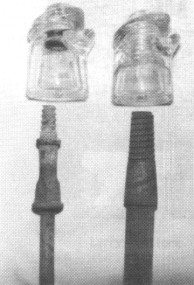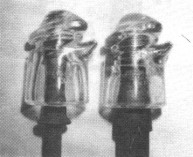Ask Woody
Reprinted from "Crown Jewels of the Wire", May 1987, page 5
I am most grateful to Mr. N.R. Woodward, Houston, Texas for his willingness
to answer readers' questions. Mr. Woodward is the author of The Glass Insulator
in America and developed the Consolidated Design Numbers identification system
for glass insulators.
Question: What are the patent dates for on insulators?
ANSWER: Patents are issued to individuals, rather than to companies. In some
cases, the patent is assigned directly to a business organization at the time it
is issued. More often only the patentee is named and the patent is later sold or
rights granted to a manufacturer for its use.
You questioned the dates associated with several different companies:
Thompson-Houston Electric, New England Glass, and Western Flint Glass. There
would not be any one patent connected directly to any of the names you listed.
Very likely some or all of these organizations obtained rights to manufacture
the insulators using design features or equipment that was protected by patents.
This information would not likely be available to us at this time.
In some cases, proper rights were not obtained prior to manufacture of
insulators; and, in those cases, there were law suits resulting in at least two
instances that we know of, the closing of the business.
Question: Where was the Star glass company located?
ANSWER: As for the Star insulators, we know very little. We do not know that
they were made by a firm named Star Glass Company. There have been a number of
companies with that or similar names; and those that we have researched have
proved to not be the source of Star insulators. We do know that the Star
insulators were marketed by General Electric Supply Company during the years
prior to World War I. At this point we have not learned the location of the
plant that manufactured them.
Question: When did the Ohio Valley Glass Company exist?
ANSWER: The years of the Ohio Valley Glass Company were 1903 and 1904 in
Cincinnati, Ohio. No evidence has been found that insulators were manufactured
by this firm. The president was Bayard L. Kilgour, who was also at that time
supervising engineer of Cincinnati and Suburban Telephone Association. We know
very little about this organization.
Question: I have a CD 145 beehive which is taller than all the others I have.
On the front and back of the insulator, there is a one centimeter slash. On the
top of the insulator dome, there is a "H."
ANSWER: The CD 145 with only a letter "H" on top and the bars on
each half-mold is a Hemingray product made at Muncie, Indiana, sometime around
1910. We do not know why they chose to leave off the familiar H.G.CO. marking on
this particular mold set; but they are relatively common in some areas, having
been mostly used on the iron-wire telegraph lines of that period. Where there is
no embossing on the skirt, the bars helped to keep the insulator from turning in
the mold during the removal of the mandrel.
QUESTION: What is the frequency of the large pinhole style of CD 128.4
Hemingray "Big Mouths?" (Mike Guthrie, Madera, California)
The piece on the left is the more common small pinhole style with metal
pinhole liner. The pin used for this style is also pictured. The piece on the
right has the standard pin hold. The embossings are the same on these two
specimens: F - Hemingray/ 2-38, B - SB. The large pinhole piece has an extra
date dot after the 38.
 |

|
| On the left is small pinhole and pin. On the right is the standard larger
pinhole with pin. |
The existence of a Hemingray - SB, CD 128.4, with standard wood pin thread
was unknown to me prior to your reporting them. The high frequency carrier
circuits were begin in the mid-1920's; and for the first ten or so years Corning
seems to have supplied all of the special insulators required. These included
the CS (CD 128); the CW (CD 122.4) and the CM (CD 100.5). During the late 1930s,
however, Owens-Illinois became involved in supplying several different styles
for field tests and they and Armstrong were subsequently established as
suppliers to AT&T after Corning discontinued insulator production.
It is that period of extensive experimentation just prior to World War II to
which the CD 128.4 belongs. Since the style was obviously developed for its
unique physical characteristics, it is not surprising that some were made for
use on standard wood pins.
In America, the 1" wood pin thread has been such a universal standard
that relatively few styles have deviated from it. It is indeed unusual to find a
single style of communication insulator made with two distinct pin hole sizes.
Some of the high voltage styles made by Corning and Hemingray (and possibly
others) were catalogued with either 1" or 1 3/8" pin holes.
| 